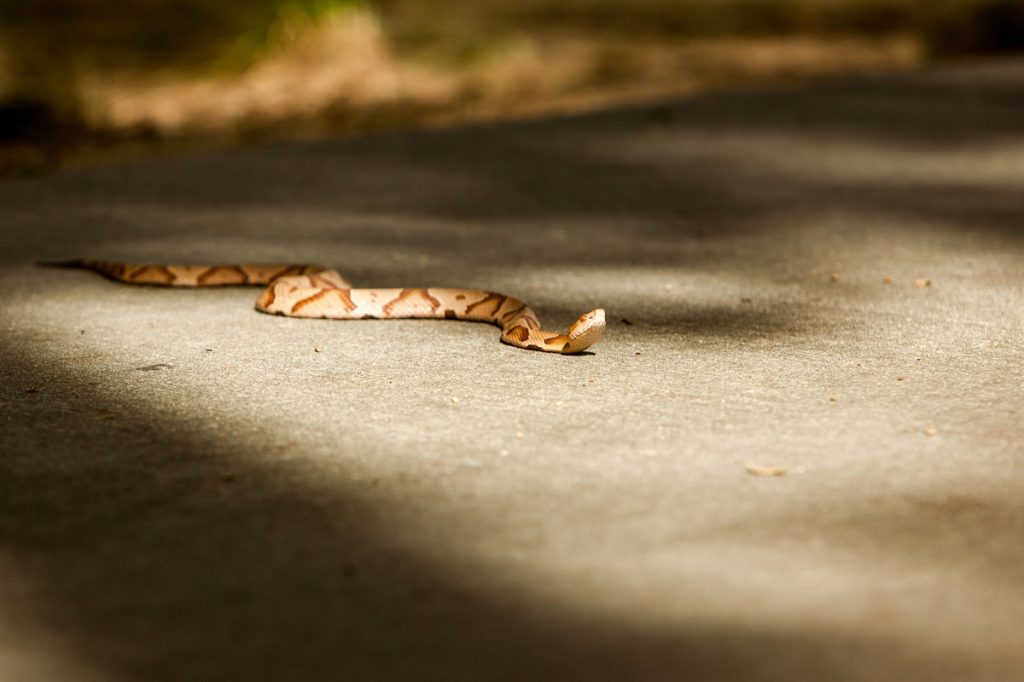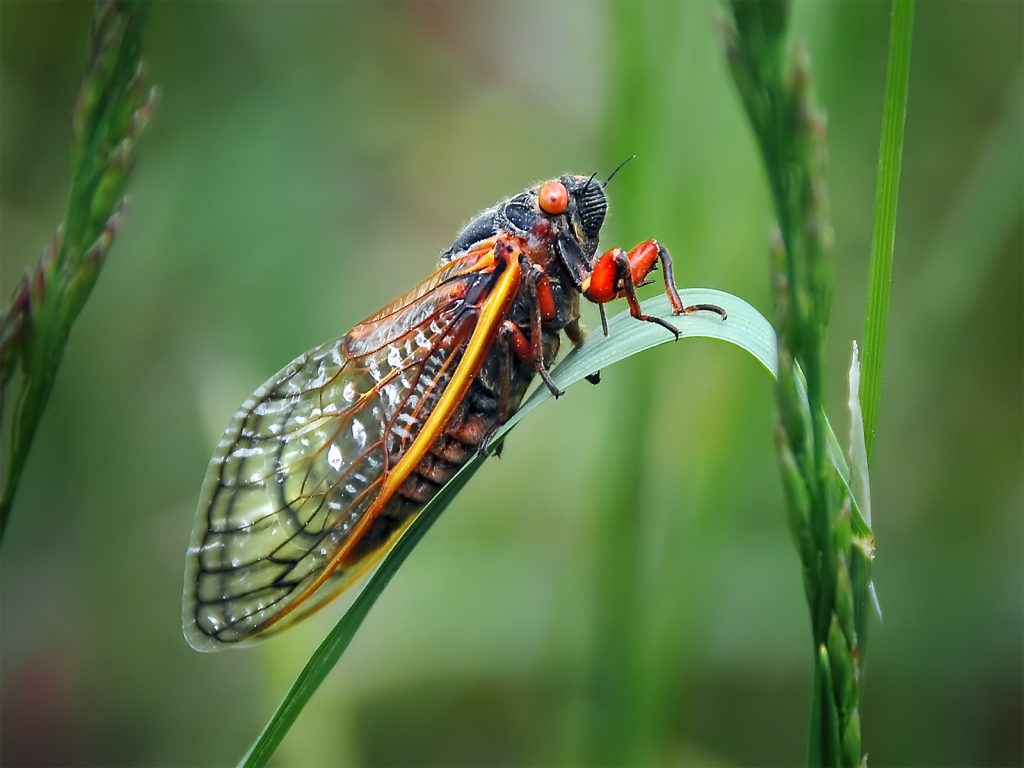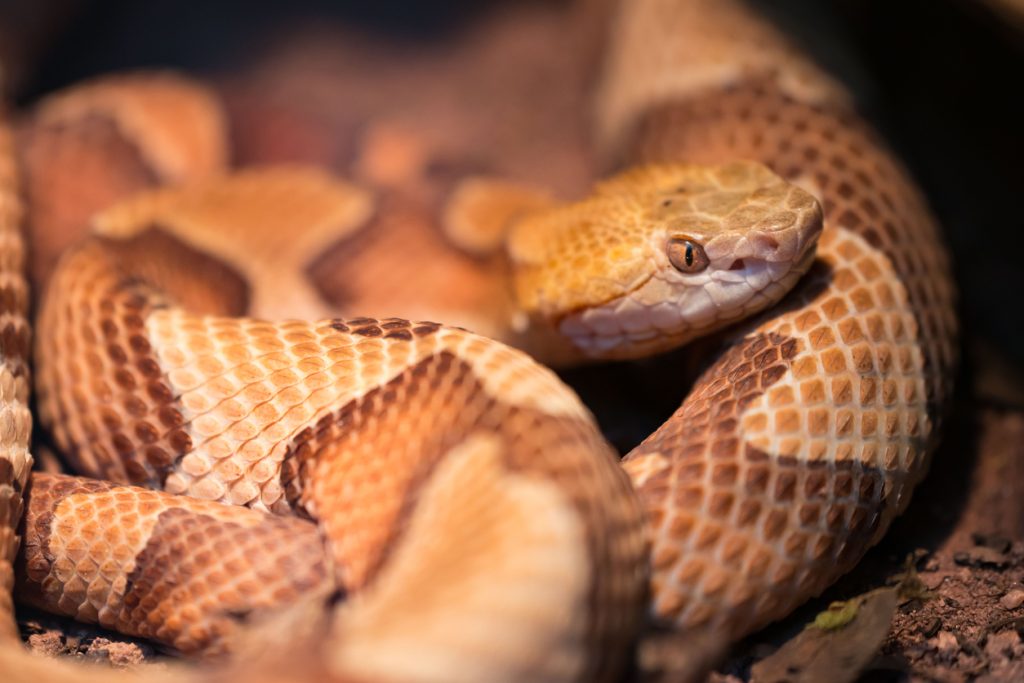3 Things Leading Copperhead Snakes to Your Home, Experts Say

When it comes to venomous snakes, copperheads can often prove to be one of the more problematic species for homeowners in many parts of the U.S. Despite the fact that they play an essential role in the food chain and can keep pests at bay, they’re also well-camouflaged and can be difficult to spot before it’s too late. And while they’re often our closest neighbors due to their wide-ranging habitat, experts say there are three specific things that copperheads are attracted to in your home. Read on to see how to keep yourself safe from any unexpected reptile run-ins.
READ THIS NEXT: 8 Plants That Will Keep Snakes Out of Your Yard, According to Pest Experts.
Copperheads like to spend the most time in two specific areas of your home.

While they may have earned a fearful reputation for their venomous bite, copperheads are still after the same things as any other wild animal: Food and shelter.
Because of this, your home’s porches and front or back steps are often two of the most common places the snakes can be found, Falyn Owens, wildlife biologist for the North Carolina Wildlife Resources Commission, told The News & Observer.
Most of this concerns the fact that our decks and front entrances often brush up closest to vegetation and bushes that can provide cover for reptiles and the rodents they prey upon. And even if your lawn is relatively pared back, porches and stairs themselves create covered spaces appealing to the animals, Owens explains.
Another part of the draw could be that porches are literally a beacon for copperhead food due to the brightness of outdoor lamps.
“Some of our snakes have learned to associate light with, ‘If I follow this, I will find food at the end,'” Talena Chavis, wildlife control agent and founder of NC Snake Catcher, told local Raleigh, North Carolina CBS affiliate WNCN in a May interview. She added that the effect was like a “dinner bell.”
They’re also fond of another noisy seasonal visitor.

But rodents aren’t the only small animals that are on the menu for copperheads. If your home is typically covered in cicadas in the warmer months, you might want to stay extra vigilant for any hungry snakes.
“Interestingly, when cicadas emerge from the ground during early summer and climb objects to molt into adults, they can be a short-lived but highly attractive food source for copperheads,” Owens told The News & Observer. “In areas where you see a lot of freshly-molted cicada casings, it’s usually a good idea to be on the alert for a copperhead that might be taking advantage of the temporary feast.”
RELATED: For more up-to-date information, sign up for our daily newsletter.
Copperheads aren’t naturally aggressive and pose no danger if you keep your distance.

The outdoor spaces of our homes will always be shared with nature and the animals that inhabit them. But even if they come by occasionally, you can drastically reduce your chances of getting bitten by a snake just by staying aware of the risks and watching for any warning signs.
“It’s important to understand that copperheads aren’t attracted to people or porches, but they may be attracted to nearby cover or food,” Owens told The News & Observer. “Close encounters between people and copperheads almost always involve the person approaching the copperhead, not the other way around.”
Other experts agree that paying attention can go a long way to avoiding a medical emergency. “A lot of our calls are just people in their garden and they’re accidentally bitten,” Jill Michels, the managing director for the Palmetto Poison Center in South Carolina, told local CBS affiliate WSPA. “They don’t see the snake or they’re doing yard work.”
If you notice a copperhead on your porch or steps, it’s best to give the animal plenty of space for it to move away on its own and not to corner it, Owens said. Be sure to keep your pets and children away from the snake. And if you’re worried about it staying too long, using a quick spray from a garden hose can sometimes get them to relocate faster.
Here’s what you should do if a copperhead snake bites you.

Owens points out that cutting back on low-lying vegetation and bushes near your home can reduce the likelihood of finding a copperhead on your porch or steps. But if you get bitten accidentally, it’s important to keep a few things in mind while seeking medical attention.
“Don’t put ice on it, do not put a tourniquet, don’t try to cut it or suck out the venom,” Michels told WSPA. “Keep calm, remove constrictive clothing, jewelry, wash and then go to your nearest emergency department.”
And while you should never try to trap or kill a snake that’s bitten you, it can be a good idea to snap a quick picture or get a good look at the reptile if it’s safe to do so.
“Try to remember the shape of it, the color of the snake because things like that can really help out the medical field when you go to the ER,” Bryant Hooper, owner of 365 Wildlife and Pest Control, told WSPA.